Grace Elliot's Blog: 'Familiar Felines.' , page 3
December 14, 2015
Gib, Gyb, or Gibbe: An Old Word for Cat
Gib or Gibbe is an old term for a cat, which was familiar to many medieval people and those in the following centuries, including Shakespeare.
“I am as melancholy as a gib cat or a lugged bear.” —Shakespeare: 1 Henry IV., i. 2.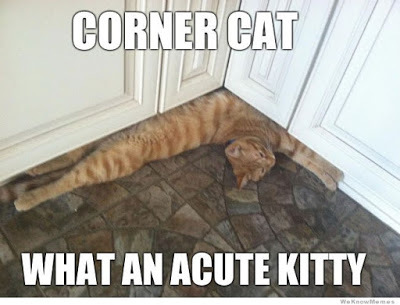
The name Gib is a contraction of the name “Gilbert” and used in a similar way that Tom cat is today. This name isn’t just restricted to the UK, but used in a slightly different form in France. The French equivalent was Tilbert or Tybalt, with the name ‘Tibbs’ being the equivalent of Gib. Indeed, Chaucer mentions both words for a cat in his Romance of the Rose.
A DigressionInterestingly, Tibby and Tibbles are sometimes still used as cat names, and this isn’t a million miles from Tiddles (could it be as a result of mishearing Tibbles?). However, a quick internet search reveals that Tiddles seems to be a derivative of an old English word ‘Tid’. This word has two meaning, of which one is a small piece, and from this we also get the word tid-bit, meaning a morsel. The other meaning is to fondle or indulge, which I guess in the context of cats makes a lot more sense.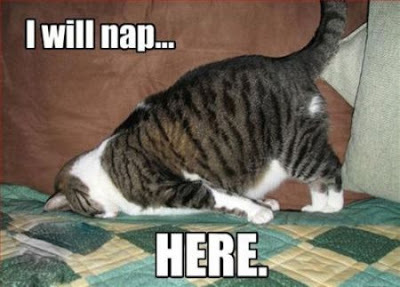
Tiddles and Lord NelsonThere is also an urban myth attached to Lord Horatio Nelson and a cat called Tiddles. There is a lovely story that Lord Nelson went into the Battle of Trafalgar accompanied by a brave companion called Tiddles. This tale gained wide and popular credence, only to be debunked in 2005 when the widow of the perpetrator came forward with the truth about her late husband's deception.
Her husband, Guy Evans, a National Trust employee, started the myth around 1990 when he falsified footnotes to a historic document and then wrote about his discovery in the Nelson Society Journal. She came forward in 2005 to expose the fraud, after the story was mentioned by Stephen Fry on the BBC’s QI program.
Back to Gib or Gibbe CatsTom cats are still widely talked about, but the term Gib has largely fallen into disuse, however this wasn’t always the case. Dr. Johnson (a great cat lover himself) remarks that “Gibbe means an old cat – I know not why.” This is interesting as a Tom cat is generally an entire (not castrated) male, whereas Gib implies old age – so perhaps we just don’t feel the need for a word describing older animals.
However, another doctor, this time Dr. Percy reports that in Northamptonshire the term means a he-cat (or male cat) which is also referred to as a ram-cat (implying they are not desexed) or in Shropshire a tup-cat (similar meaning.) However, numerous dictionaries, including Merriam-Webster give the definition of Gib as meaning neutered or castrated, which is all very confusing.
Phillip SparrowAnother mention of Gib the cat comes in the 15thcentury poem, The Book of Phillip Sparrow by John Skelton. To call Phylyp agayne,Whom Gyb our cat hath slayne.
Gib, I saye, our cat,Worrowyd her on thatWhich I loved best:
This poem tells the story of the loss of a pet sparrow, murdered by a cat.. called Gib.
So is the name Gib or Gilbert creeping up the list of names to call your next cat…or perhaps Tiddles?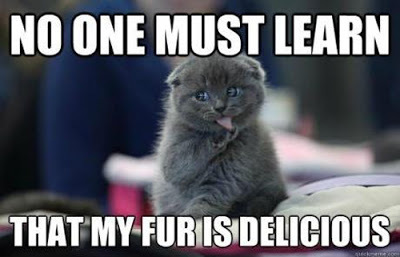
“I am as melancholy as a gib cat or a lugged bear.” —Shakespeare: 1 Henry IV., i. 2.

The name Gib is a contraction of the name “Gilbert” and used in a similar way that Tom cat is today. This name isn’t just restricted to the UK, but used in a slightly different form in France. The French equivalent was Tilbert or Tybalt, with the name ‘Tibbs’ being the equivalent of Gib. Indeed, Chaucer mentions both words for a cat in his Romance of the Rose.
A DigressionInterestingly, Tibby and Tibbles are sometimes still used as cat names, and this isn’t a million miles from Tiddles (could it be as a result of mishearing Tibbles?). However, a quick internet search reveals that Tiddles seems to be a derivative of an old English word ‘Tid’. This word has two meaning, of which one is a small piece, and from this we also get the word tid-bit, meaning a morsel. The other meaning is to fondle or indulge, which I guess in the context of cats makes a lot more sense.

Tiddles and Lord NelsonThere is also an urban myth attached to Lord Horatio Nelson and a cat called Tiddles. There is a lovely story that Lord Nelson went into the Battle of Trafalgar accompanied by a brave companion called Tiddles. This tale gained wide and popular credence, only to be debunked in 2005 when the widow of the perpetrator came forward with the truth about her late husband's deception.
Her husband, Guy Evans, a National Trust employee, started the myth around 1990 when he falsified footnotes to a historic document and then wrote about his discovery in the Nelson Society Journal. She came forward in 2005 to expose the fraud, after the story was mentioned by Stephen Fry on the BBC’s QI program.
Back to Gib or Gibbe CatsTom cats are still widely talked about, but the term Gib has largely fallen into disuse, however this wasn’t always the case. Dr. Johnson (a great cat lover himself) remarks that “Gibbe means an old cat – I know not why.” This is interesting as a Tom cat is generally an entire (not castrated) male, whereas Gib implies old age – so perhaps we just don’t feel the need for a word describing older animals.
However, another doctor, this time Dr. Percy reports that in Northamptonshire the term means a he-cat (or male cat) which is also referred to as a ram-cat (implying they are not desexed) or in Shropshire a tup-cat (similar meaning.) However, numerous dictionaries, including Merriam-Webster give the definition of Gib as meaning neutered or castrated, which is all very confusing.

Phillip SparrowAnother mention of Gib the cat comes in the 15thcentury poem, The Book of Phillip Sparrow by John Skelton. To call Phylyp agayne,Whom Gyb our cat hath slayne.
Gib, I saye, our cat,Worrowyd her on thatWhich I loved best:
This poem tells the story of the loss of a pet sparrow, murdered by a cat.. called Gib.
So is the name Gib or Gilbert creeping up the list of names to call your next cat…or perhaps Tiddles?

Published on December 14, 2015 00:55
November 30, 2015
Women’s PostWar Problems by guest, Freda Lightfoot
Today I'm delighted to welcome Sunday Times best-selling author Freda Lightfoot to "Fall in Love with History". Freda has written a thought-provoking post about how people change during wartime, and how a reunion did not always mean a happy ending. G x

WOMEN'S POST WAR PROBLEMS
Most women had endured six years of war work and being entirely responsible for their children. Sometimes children were sent away as evacuees, so there would have been no family life. Women became much tougher as a result of doing men’s jobs, which didn’t always go down well. When their husbands returned they did not expect their wives to have gained so much freedom and independence. They had dreamed of the young and beautiful girl they’d married. Now she’d aged somewhat and that didn’t always appeal either. She could find herself dismissed from her job when the fighting men returned, even though she might be a war widow with no home or pension, or even a deserted wife. The government insisted she return to her wifely duties, keeping house and producing and caring for children, which felt to some like going back to prison.
She also might have to deal with a shell-shocked or disfigured husband, who suffered from sleepwalking or nightmares, outbursts of violence or depression. He could have turned into a bit of a bully if he was accustomed to giving orders. He might also struggle to find work, or resent having to return to his boring desk job, finding it difficult to settle back into Civvy Street. Children too would often react badly as they didn’t even know their father, having rarely seen him.
But women too had suffered traumas. Perhaps remembered being buried alive for hours in a bombed-out house. The after effects might mean they couldn’t bear to go in lifts, sit in dark places such as a cinema, or experienced fainting fits or even heart attacks. She was most likely to be exhausted after the years of hard work, something their men folk didn’t always comprehend.
The effect of war upon a marriage or relationship was not always good either. Some couples were happy to be back together again and their love blossomed. Others were less fortunate, particularly if they’d suffered traumatic situations, or long periods of separation. It was often considered acceptable for men to satisfy their needs while fighting overseas and befriend girls, but complete fidelity was expected from wives. Why would a woman feel happy about that? And once back together, their personalities having changed somewhat, they could feel like strangers. This was particularly true of hasty war marriages.
When World War II ended there was a strange sense of anti-climax, as if the bright blue, sun-filled sky had clouded over leaving a feeling of uncertainty about the future. But then the country was in a mess, still enduring shortages and rationing, a lack of homes and jobs, and near bankruptcy. There were bombed areas and rubble everywhere, homes lost or wrecked, many empty shops, huge bomb craters everywhere, and loved ones lost. This was the brave new world that women had fought for, but not at all what they’d expected. They needed infinite patience, tact and strength to rebuild their lives.
Thank you, Freda! It hadn't struck me before, how peoples differing experiences of war could push them apart. It sounds a great idea for a novel. Oh wait....G x
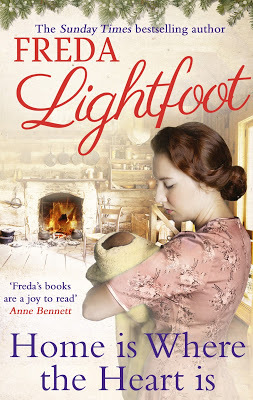
'Home is Where the Heart Is' Blurb
1945: Christmas is approaching and Cathie Morgan is awaiting the return of her beloved fiancé, Alexander Ramsay. But she has a secret that she’s anxious to share with him. One that could change everything between them. Her sister has died and she wants to adopt her son. When the truth is finally revealed, Alex immediately calls off the wedding, claiming that the baby is actually Cathie’s, causing all of Cathie’s fears to be realised. As Cathie battles to reassure Alex of her fidelity, she must also juggle the care of the baby and their home.
But then Alex crosses the line with a deceit that is unforgivable, leaving Cathie to muster the courage to forge a life for her and her nephew alone. Will Cathie ever be able to trust another man again and as peace begins to settle will she ever be able to call a house a home…
Freda's Bio: Born in Lancashire, Freda Lightfoot has been a teacher, bookseller and in a mad moment even tried her hand at the 'good life' as a smallholder in the English Lake District. Inspired by this tough life on the fells, memories of her Lancashire childhood, and her passion for history she has published over forty sagas and historical novels. Freda has lived in the Lake District and Cornwall but now lives in Spain in the winter but still likes to spend rainy summers in the UK.
For more information visit her website
Find Freda on Facebook
Or on Twitter
And at Goodreads
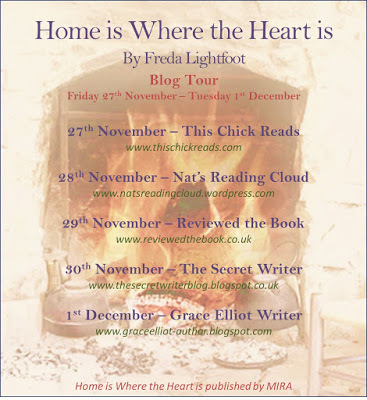

WOMEN'S POST WAR PROBLEMS
Most women had endured six years of war work and being entirely responsible for their children. Sometimes children were sent away as evacuees, so there would have been no family life. Women became much tougher as a result of doing men’s jobs, which didn’t always go down well. When their husbands returned they did not expect their wives to have gained so much freedom and independence. They had dreamed of the young and beautiful girl they’d married. Now she’d aged somewhat and that didn’t always appeal either. She could find herself dismissed from her job when the fighting men returned, even though she might be a war widow with no home or pension, or even a deserted wife. The government insisted she return to her wifely duties, keeping house and producing and caring for children, which felt to some like going back to prison.
She also might have to deal with a shell-shocked or disfigured husband, who suffered from sleepwalking or nightmares, outbursts of violence or depression. He could have turned into a bit of a bully if he was accustomed to giving orders. He might also struggle to find work, or resent having to return to his boring desk job, finding it difficult to settle back into Civvy Street. Children too would often react badly as they didn’t even know their father, having rarely seen him.
But women too had suffered traumas. Perhaps remembered being buried alive for hours in a bombed-out house. The after effects might mean they couldn’t bear to go in lifts, sit in dark places such as a cinema, or experienced fainting fits or even heart attacks. She was most likely to be exhausted after the years of hard work, something their men folk didn’t always comprehend.
The effect of war upon a marriage or relationship was not always good either. Some couples were happy to be back together again and their love blossomed. Others were less fortunate, particularly if they’d suffered traumatic situations, or long periods of separation. It was often considered acceptable for men to satisfy their needs while fighting overseas and befriend girls, but complete fidelity was expected from wives. Why would a woman feel happy about that? And once back together, their personalities having changed somewhat, they could feel like strangers. This was particularly true of hasty war marriages.
When World War II ended there was a strange sense of anti-climax, as if the bright blue, sun-filled sky had clouded over leaving a feeling of uncertainty about the future. But then the country was in a mess, still enduring shortages and rationing, a lack of homes and jobs, and near bankruptcy. There were bombed areas and rubble everywhere, homes lost or wrecked, many empty shops, huge bomb craters everywhere, and loved ones lost. This was the brave new world that women had fought for, but not at all what they’d expected. They needed infinite patience, tact and strength to rebuild their lives.
Thank you, Freda! It hadn't struck me before, how peoples differing experiences of war could push them apart. It sounds a great idea for a novel. Oh wait....G x

'Home is Where the Heart Is' Blurb
1945: Christmas is approaching and Cathie Morgan is awaiting the return of her beloved fiancé, Alexander Ramsay. But she has a secret that she’s anxious to share with him. One that could change everything between them. Her sister has died and she wants to adopt her son. When the truth is finally revealed, Alex immediately calls off the wedding, claiming that the baby is actually Cathie’s, causing all of Cathie’s fears to be realised. As Cathie battles to reassure Alex of her fidelity, she must also juggle the care of the baby and their home.
But then Alex crosses the line with a deceit that is unforgivable, leaving Cathie to muster the courage to forge a life for her and her nephew alone. Will Cathie ever be able to trust another man again and as peace begins to settle will she ever be able to call a house a home…
Freda's Bio: Born in Lancashire, Freda Lightfoot has been a teacher, bookseller and in a mad moment even tried her hand at the 'good life' as a smallholder in the English Lake District. Inspired by this tough life on the fells, memories of her Lancashire childhood, and her passion for history she has published over forty sagas and historical novels. Freda has lived in the Lake District and Cornwall but now lives in Spain in the winter but still likes to spend rainy summers in the UK.
For more information visit her website
Find Freda on Facebook
Or on Twitter
And at Goodreads

Published on November 30, 2015 12:00
November 29, 2015
Gottfried Mind: The Cat Raphael
Recently, in a Victorian book of cat miscellany (*) I came upon a passing reference to Gottfried Mind, as the “Cat Raphael”. This of course, whetted my appetite to find out more because anyone who can capture the character of cats is all right by me.
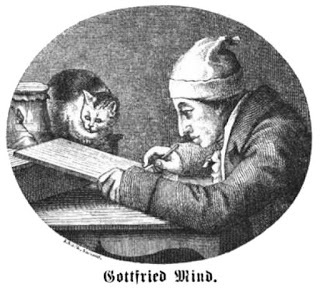
Gottfried Mind (1768 – 1814) was born in Switzerland, the son of a carpenter. But Mind was a sickly child with a weak constitution, and he was also autistic. At an early age Gottfried showed a talent for drawing, but his father believed the only medium worth working with was wood. He would give his son pieces of wood and indeed the young Gottfried became a talented carver. His miniature sheep and cows were popular with the locals, who displayed them on their mantelpieces. However, Gottfried’s real passion was drawing.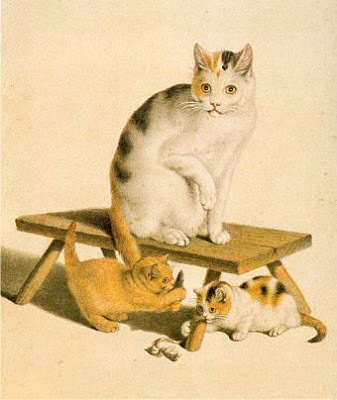
Gottfried was sent away to school, but lasted only a year. As explained by the head teacher, his pupil was: “Incapable of any demanding work, but full of talent for drawing, especially God’s creatures, which he renders full of artistic caprices and with some wit.” Gottfried returned home to become an apprentice to a printer called Sigmund Hendenberger. Gottfried’s job was to hand color the prints created by his master. The story goes that Gottfried’s talent for drawing felines was discovered by accident.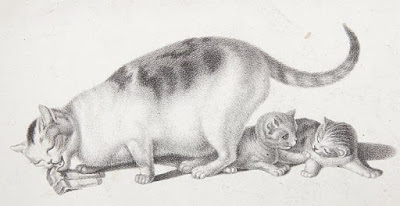
Hendenberger visited a village (to create “Peasant Clearing Wood”) showing a man chopping wood, whilst his wife sits spooning food into a child, with a cat winding round her ankles. When Gottfried saw his master’s rendition of the cat, he said: “That’s no cat.” Hendenberger took this as a challenge and suggested if his apprentice could do better, go ahead.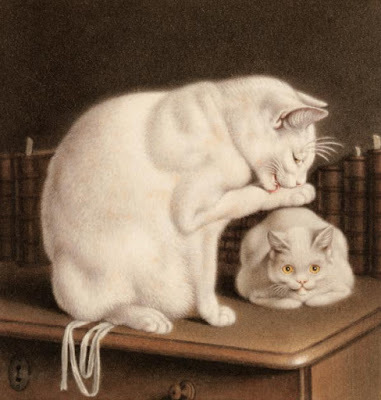
The sketch that Gottfried produced so enchanted Hendenberger that he copied his pupil’s work. The pair worked on together for years, but it wasn’t until after his master’s death and his widow encouraged Gottfried to produce original works to bring in more money, that Gottfried gave free rein to his talent.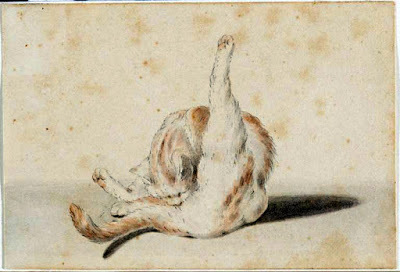
His poor health meant he spent a lot of time indoors, usually accompanied by a cat. It seems he had a near photographic memory, as he only had to visit a scene and stare for a while, to return home and render it faithfully in paint. And when Gottfried wanted to relax, his party piece was to carve miniature models of cats out of chestnuts. Sadly, Gottfried Mind suffered from an “increasing disorder in his breast” which brought about his death in 1914, at the tragically young age of 46.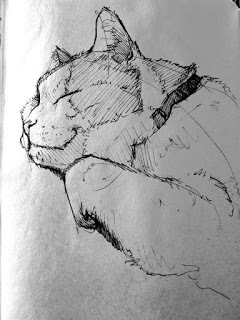 ...and this one is by my son.
...and this one is by my son.
(*) The Book of Cats: A Chit-Chat Chronicle of Feline Facts and Fancies, Legendary, Lyrical, Medical, Mirthful and Miscellaneous (1868) Charles Henry Ross.

Gottfried Mind (1768 – 1814) was born in Switzerland, the son of a carpenter. But Mind was a sickly child with a weak constitution, and he was also autistic. At an early age Gottfried showed a talent for drawing, but his father believed the only medium worth working with was wood. He would give his son pieces of wood and indeed the young Gottfried became a talented carver. His miniature sheep and cows were popular with the locals, who displayed them on their mantelpieces. However, Gottfried’s real passion was drawing.

Gottfried was sent away to school, but lasted only a year. As explained by the head teacher, his pupil was: “Incapable of any demanding work, but full of talent for drawing, especially God’s creatures, which he renders full of artistic caprices and with some wit.” Gottfried returned home to become an apprentice to a printer called Sigmund Hendenberger. Gottfried’s job was to hand color the prints created by his master. The story goes that Gottfried’s talent for drawing felines was discovered by accident.

Hendenberger visited a village (to create “Peasant Clearing Wood”) showing a man chopping wood, whilst his wife sits spooning food into a child, with a cat winding round her ankles. When Gottfried saw his master’s rendition of the cat, he said: “That’s no cat.” Hendenberger took this as a challenge and suggested if his apprentice could do better, go ahead.

The sketch that Gottfried produced so enchanted Hendenberger that he copied his pupil’s work. The pair worked on together for years, but it wasn’t until after his master’s death and his widow encouraged Gottfried to produce original works to bring in more money, that Gottfried gave free rein to his talent.

His poor health meant he spent a lot of time indoors, usually accompanied by a cat. It seems he had a near photographic memory, as he only had to visit a scene and stare for a while, to return home and render it faithfully in paint. And when Gottfried wanted to relax, his party piece was to carve miniature models of cats out of chestnuts. Sadly, Gottfried Mind suffered from an “increasing disorder in his breast” which brought about his death in 1914, at the tragically young age of 46.
 ...and this one is by my son.
...and this one is by my son. (*) The Book of Cats: A Chit-Chat Chronicle of Feline Facts and Fancies, Legendary, Lyrical, Medical, Mirthful and Miscellaneous (1868) Charles Henry Ross.
Published on November 29, 2015 11:15
November 15, 2015
Saint Julian of Norwich and her Cat
Last week’s post posed the question: Who is the patron saint of cats? One visitor to the blog, Susan Lester, left an intriguing comment that needed further investigation. Susan mentioned Saint Julian of Norwich as being a contender for the official protector of felines. I’d never heard of Saint Julian, so I decided to find out more.
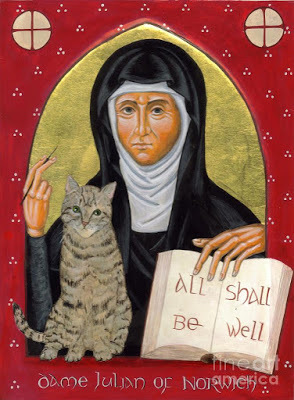 A depiction of Saint Julian and her cat
A depiction of Saint Julian and her cat(although it seems likely she wasn't a nun)
Indeed, Saint Julian is strongly linked to cats (although not named as their patron saint), most especially because her sole companion was feline. But I jump ahead, let’s start at the beginning and find out who Julian was, along with where and when she lived. Julian lived in the 14th century, at a time when the Black Death was ravaging England. Harvests failed, the people were poor and starving, whilst taxes were high. The climax of this was a young King Richard II was on the throne, and the Peasant’s Revolt of 1381. A poll tax was levied to pay for the Hundred Years War with France, and when officials tried to enforce payment, the peasants fought back.
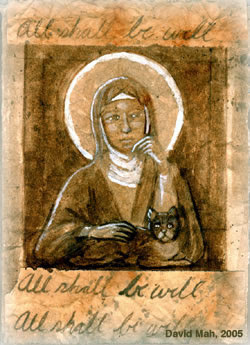
This was a time of great unrest, with Wat Tyler raising a group of fighting men to try and storm the Tower of London. In the midst of the social distress, lack of food, and risk of the plague they were dark times indeed. But Julian felt a calling to ‘anchor the light of God’ on earth. Little is known about Julian’s earlier life, and our main clue is Julian’s own words where she refers to herself as a “Simple, uneducated woman.”Julian’s mission was to represent a quiet oasis of calm, in the midst of all the strife. To do this she became an anchoress in a cell, in a church in Norfolk. Indeed, it seems likely she took her name from that of the church, Julian, Bishop of Le Mans, where she lived.
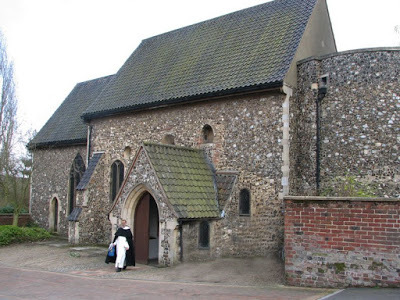 The church from which Julian took her saintly name.
The church from which Julian took her saintly name.Her purpose was to live a life of solitude and prayer, and provide counsel via a small curtained window to those that needed it. She lived entirely with a small cell and a small enclosed yard with a high wall. That one room had three small windows: One so she could hear Mass and take the Sacrament, a second where a servant placed her food, and the third through which she gave counsel.
However, she did have a companion, in the shape of a cat. This was for entirely practical reasons, in order to keep the rat population down. But it seems likely that Julian and that cat struck up a very close relationship, and that feline certainly must have been a bright light to Saint Julian in those dark times.(Thank you to Susan, for bringing Saint Julian to my attention.)

Published on November 15, 2015 13:16
November 8, 2015
Who is the Patron Saint of Cats?
Who is the patron saint of cats? You might think a likely candidate was Saint Francis of Assisi, but you’d be wrong. St Francis is the patron saint of animals (including cats) but apart from being an all-round good egg when it came to animals he had not extra special affinity for cats.
 Saint Francis of Assisi
Saint Francis of Assisi
Another possibility is Saint Mary Bartholomew Bagnesi. She lived in the 16th century and was a Dominican nun who suffered poor health. It seems cats liked Mary, and stayed with her in her sick room. Indeed, cats seem to be a sort of guardian angel for Mary. “At least once when the cats knew Maria was hungry and hadn’t been looked after they went and fetched cheese for her to eat.” The Catholic Herald.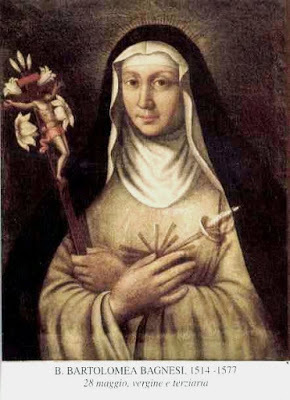 Mary Bartholomew Bagnesi
Mary Bartholomew Bagnesi
But no, Mary is the saint we are looking for: Her area of patronage falls on the abused, the sick, and as a protector of parents.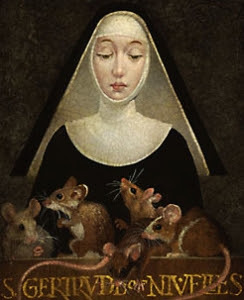 Gertrude of Nivelles
Gertrude of Nivelles
Patron saint of cats
Rather confusingly with some rats
In truth this is a trick question because there is no ‘official’ patron saint of cats, although St. Gertrude of Nivelles unofficially holds the honor. Gertrude is the patron saint of travelers, gardeners, and protects against mental illness…and rats. The latter is possibly where her associated with cats began. Many pictures of Saint Gertrude show her with a mouse on her staff, which is where it all gets a little confusing.
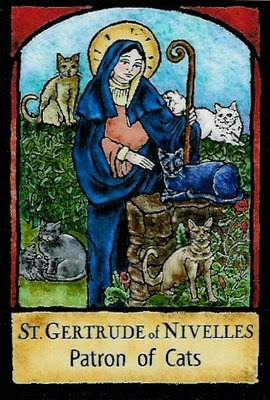
Whilst she was said to protect against rats and mice, the mice shown with her in pictures are said to represent the souls of the recently deceased in purgatory (whom she is also patron saint of). Whichever way round things are (mice good or mice bad) it seems Gertrude was kind to all the cats in the convent gardens, and cats were encouraged there in order to keep the vermin population under control.
Gertrude was born in Belgium, in 626, and died aged 33, in 659. However, it wasn’t until the Middle Ages that she popularly became linked to cats, so perhaps it was more wishful thinking than fact, to put right a wrong that cats should have their own saint.
Oh, and Gertrude's saint's day is March 17.
 Saint Francis of Assisi
Saint Francis of AssisiAnother possibility is Saint Mary Bartholomew Bagnesi. She lived in the 16th century and was a Dominican nun who suffered poor health. It seems cats liked Mary, and stayed with her in her sick room. Indeed, cats seem to be a sort of guardian angel for Mary. “At least once when the cats knew Maria was hungry and hadn’t been looked after they went and fetched cheese for her to eat.” The Catholic Herald.
 Mary Bartholomew Bagnesi
Mary Bartholomew BagnesiBut no, Mary is the saint we are looking for: Her area of patronage falls on the abused, the sick, and as a protector of parents.
 Gertrude of Nivelles
Gertrude of NivellesPatron saint of cats
Rather confusingly with some rats
In truth this is a trick question because there is no ‘official’ patron saint of cats, although St. Gertrude of Nivelles unofficially holds the honor. Gertrude is the patron saint of travelers, gardeners, and protects against mental illness…and rats. The latter is possibly where her associated with cats began. Many pictures of Saint Gertrude show her with a mouse on her staff, which is where it all gets a little confusing.

Whilst she was said to protect against rats and mice, the mice shown with her in pictures are said to represent the souls of the recently deceased in purgatory (whom she is also patron saint of). Whichever way round things are (mice good or mice bad) it seems Gertrude was kind to all the cats in the convent gardens, and cats were encouraged there in order to keep the vermin population under control.

Gertrude was born in Belgium, in 626, and died aged 33, in 659. However, it wasn’t until the Middle Ages that she popularly became linked to cats, so perhaps it was more wishful thinking than fact, to put right a wrong that cats should have their own saint.
Oh, and Gertrude's saint's day is March 17.

Published on November 08, 2015 12:05
October 29, 2015
Hares and Rabbits in Medieval England - by Regan Walker
A warm welcome to guest Regan Walker, who posts on the 'hop'-topic of Hares and Rabbits in Medieval England. G x
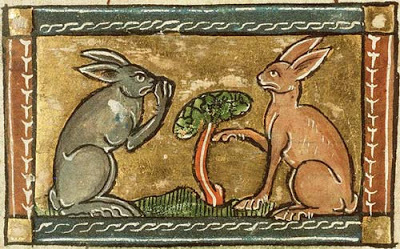 Medieval rabbits
Medieval rabbitsThough both hares and rabbits existed in medieval England, the rabbit was a rare beast and much sought after for both its meat and its fur. Unlike the hare, the rabbit was not native to Britain, but was deliberately introduced from France or the western Mediterranean by the 13th century. While the hare is considered native to Britain, it is possible the Romans may have introduced it. However, there are no records of them in Britain before Norman times, the 11th century.
My new novel, Rogue Knight, is set in Yorkshire in 1069-70 when William the Conqueror came north to claim Northumbria and engaged in the debacle we know today as the “Harrying of the North” causing the deaths of as many as 100,000 people.
 The Yorkshire Dales
The Yorkshire DalesI like to think that some people, chased from their homes by William’s army and deprived of the ability to grow food, might have survived on the brown hare, native to Yorkshire. Certainly my heroine and her family, hiding out from the Normans, dined on hare while living in the woods.
The brown hare is generally larger than a rabbit. They have long, black-tipped ears and a tall and leggy appearance. They are timid and fast runners. They prefer grassland fields and some woodland in their habitat. In the Peak District of England, you will find the smaller mountain hare.
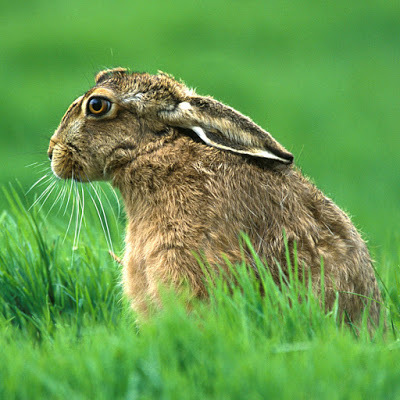 The Brown Hare by Whitfield Benson
The Brown Hare by Whitfield BensonUnlike young rabbits, that are born blind and furless, totally dependent upon their mother, young brown hares, called leverets, are born fully formed and active, weaned in a month. Their average life expectancy is three years. Rabbits raised in captivity might live longer. In the Middle Ages, rabbit-warrens were almost the sole source of supply for rabbits and that is one reason they were so valuable and closely guarded.
Throughout the medieval era, beginning after the Norman Conquest the right to hunt and kill any beast or game was a privilege granted by the king. The Anglo-Saxon Chronicle in a verse written shortly after his death states, “He made great protection for the game and imposed laws for the same, that who so slew hart or hind should be made blind.” (William the Conqueror seemed to love poking out people’s eyes.) And, as for the hares, “…did he decree that they should go free.” (Meaning they could not be hunted for the Chronicle indicates “Powerful men complained of it and poor man lamented it, but so fierce was he that he cared not for the rancor of them all…”)
 Brown Hare by Matt NealeIt appears that the royal forests of the kind that existed in the 12th century were, thus, a Norman creation. The Domesday Book, written in 1086 at the order of William I, indicates that the royal forest was created though a combination of eviction and the taking of woodland and uninhabited land. At the height of the royal forest practice in the late 12th and early 13th centuries, fully one-third of the land area of southern England was designated as royal forest.
Brown Hare by Matt NealeIt appears that the royal forests of the kind that existed in the 12th century were, thus, a Norman creation. The Domesday Book, written in 1086 at the order of William I, indicates that the royal forest was created though a combination of eviction and the taking of woodland and uninhabited land. At the height of the royal forest practice in the late 12th and early 13th centuries, fully one-third of the land area of southern England was designated as royal forest.Hunting in the royal forests was the privilege of the king alone. Outside of those areas, the king would sell hunting rights by means of a charter that allowed the killing of the “beasts of warren”—pheasant, partridge, hare and rabbit. Hence the right to keep and kill rabbits was the exclusive right of the owner of the “free-warren”. Grants of warren—the right to hunt hares—can be found from the reign of at least William II and perhaps William I.
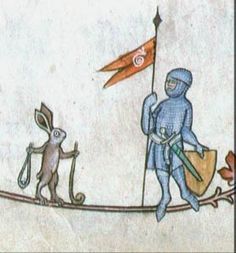 Hare and Knight
Hare and KnightHenry I, as reported in the Gesta Stephani, “claimed for himself sole hunting rights of wild beasts throughout England…” That doesn’t leave a poor man many options to feed his family, but perhaps a hare in a remote area found its way into a poor family’s stewpot.
A huge thank you to Regan for this fascinating and hare-raising post! As ever Regan lives and breathes history, and I'm grateful to her for sharing that love with us. So let's 'hop' to it and find out about Regan's latest release...Rogue Knight.
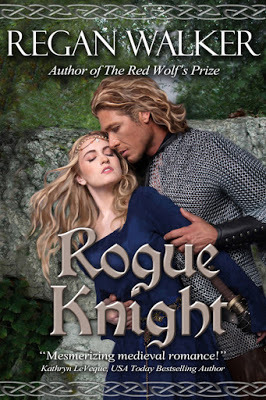 THE ROGUE KNIGHT
THE ROGUE KNIGHT"Mesmerizing medieval romance! A vivid portrayal of love flourishing amidst the turbulence of the years after the Norman Conquest."-- Kathryn Le Veque, USA Today Bestselling Author
York, England 1069… three years after the Norman Conquest
The North of England seethes with discontent under the heavy hand of William the Conqueror, who unleashes his fury on the rebels who would dare to defy him. Amid the ensuing devastation, love blooms in the heart of a gallant Norman knight for a Yorkshire widow.
A LOVE NEITHER CAN DENY, A PASSION NEITHER CAN RESIST
Angry at the cruelty she has witnessed at the Normans’ hands, Emma of York is torn between her loyalty to her noble Danish father, a leader of the rebels, and her growing passion for an honorable French knight.
Loyal to King William, Sir Geoffroi de Tournai has no idea Emma hides a secret that could mean death for him and his fellow knights.
WAR DREW THEM TOGETHER, WAR WOULD TEAR THEM APART
War erupts, tearing asunder the tentative love growing between them, leaving each the enemy of the other. Will Sir Geoffroi, convinced Emma has betrayed him, defy his king to save her?
Regan Walker websiteRegan Walker on FacebookPinterest storyboard for the Rogue Knight (Always worth checking out!)
Published on October 29, 2015 02:44
October 25, 2015
Unofficial London: The Grizzly Story of Bunhill Fields
“Elizabeth Hare, lately condemned for high treason in clipping his Majesty’s coin, was according to her sentence, burnt alive in Bunhill Field”. Diary of Narcissus Luttrell October 30th, 1683This one sentence is intriguing as it yields up not one story but three: Elizabeth Hare, coin clipping, and that of the place called Bunhill Fields.
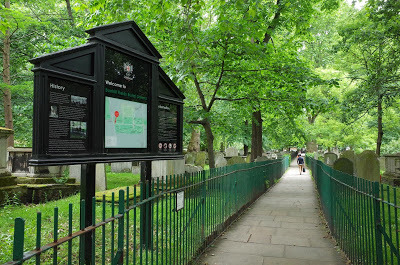 The entrance to Bunhill Fields Memorial Gardens in the modern dayIn a forthcoming post on the EHFA (English Historical Fiction Authors) blog, I discuss the crime for which Elizabeth Hare is condemned: Coin clipping. In this post, let’s investigate the intriguing mention of “Bunhill Fields”. (Oh, and in case I forget to mention it later, isn’t the diarist’s name fantastic: Narcissus.)
The entrance to Bunhill Fields Memorial Gardens in the modern dayIn a forthcoming post on the EHFA (English Historical Fiction Authors) blog, I discuss the crime for which Elizabeth Hare is condemned: Coin clipping. In this post, let’s investigate the intriguing mention of “Bunhill Fields”. (Oh, and in case I forget to mention it later, isn’t the diarist’s name fantastic: Narcissus.)
The Long History of Bunhill FieldsHad you heard of Bunhill Fields, London? I hadn’t, so I was keen to find out more. Intriguingly Bunhill Fields is linked to two more famous areas; Smithfield and Moorfields, which warrants a brief digression· Smithfield Market: Since the 13th century Smithfield hosted a market, traditionally a trading place for livestock. It was also a place of execution (like Bunhill) and was the Scottish hero William Wallace met his end. Also “Smith” was a derivation of “Smooth” meaning flat, so the area was originally named for being a flat field.
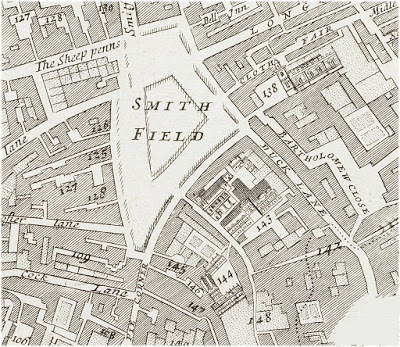 Smithfield from a made circa 1720
Smithfield from a made circa 1720
· Moorfields (which gave its name to the famous Moorfield’s Eye Hospital, London – although this is now on a different site) was an open patch of ground within the city walls. It was to Moorfields that many Londoners fled to as a place of safety during the Great Fire of 1666.
 Detail from a map of Moorfields circa 1550
Detail from a map of Moorfields circa 1550
In the 12th century Bunhill Fields, Smithfield, and Moorfields belonged to the Manor of Finsbury. The area has been used as a burial ground since Saxon times. In this context the name “Field” came to mean an open piece of land to be used for communal purposes other than the cultivation of crops. Some of the activities that went on there include grazing animals, bleaching linen cloth in the sun, archery practice and other such activities that required space.
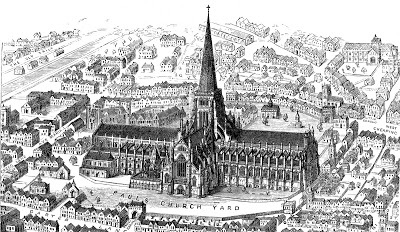 Old Saint Paul's Cathedral
Old Saint Paul's Cathedral
Note the churchyard in the foregroundThe area was managed by the Corporation of London but between 1514 and 1867 ownership passed to the Dean of St. Paul’s Cathedral. Our area of interest was known as Bone Hill – because it was literally a dumping ground for bones. Any hollows in the field were filled in with rubbish such as rags and bones from Smithfield shambles. Indeed in 1549 St Paul’s Cathedral had a clear out in their Charnel House and over one thousand cartloads of human bones were taken to “Bone Hill” for disposal.
 The ruins of Old Saint Paul's as it appeared
The ruins of Old Saint Paul's as it appeared
around 7 years after the Great Fire of 1666The Charnel House had become full as a result of moving dead Londoners buried in St Paul’s Churchyard, out of the graveyard after a certain period of time. After burial, a respectable amount of time was left to let the flesh rot away, and then the bones were dug up and moved into storage in the Charnel House to await resurrection. However, by 1549 the Charnel House was full to overflowing hence the unceremonius move to Bone Hill.
These measures managed the problem of space for burials for about a century, but by 1665 the graveyard at St Paul’s was once more full. So Alderman Sir John Robinson entered into an agreement to use land at Bone Hill as an extension of the cathedral’s burial ground.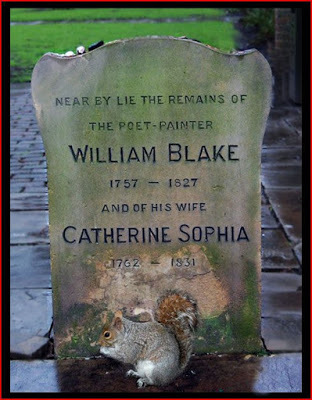 William Blake's gravestone
William Blake's gravestone
in Bunhill Fields graveyardIndeed, Bunhill, as it was now know, was home to the graves of many great or famous people such as John Bunyan (died 1688) Daniel Defoe (D.1731, author of Robinson Crusoe) and William Blake (D.1827) Of course, it also seems the area of Bunhill Fields was also used as a place of public execution, such as for Elizabeth Hare.
And in the modern day? Bunhill Fields still exists, but as a public park managed by the City of London. Around 2,000 monuments and head stones still remain, but the grizzly spectacle of public executions has long since finished.

 The entrance to Bunhill Fields Memorial Gardens in the modern dayIn a forthcoming post on the EHFA (English Historical Fiction Authors) blog, I discuss the crime for which Elizabeth Hare is condemned: Coin clipping. In this post, let’s investigate the intriguing mention of “Bunhill Fields”. (Oh, and in case I forget to mention it later, isn’t the diarist’s name fantastic: Narcissus.)
The entrance to Bunhill Fields Memorial Gardens in the modern dayIn a forthcoming post on the EHFA (English Historical Fiction Authors) blog, I discuss the crime for which Elizabeth Hare is condemned: Coin clipping. In this post, let’s investigate the intriguing mention of “Bunhill Fields”. (Oh, and in case I forget to mention it later, isn’t the diarist’s name fantastic: Narcissus.)The Long History of Bunhill FieldsHad you heard of Bunhill Fields, London? I hadn’t, so I was keen to find out more. Intriguingly Bunhill Fields is linked to two more famous areas; Smithfield and Moorfields, which warrants a brief digression· Smithfield Market: Since the 13th century Smithfield hosted a market, traditionally a trading place for livestock. It was also a place of execution (like Bunhill) and was the Scottish hero William Wallace met his end. Also “Smith” was a derivation of “Smooth” meaning flat, so the area was originally named for being a flat field.
 Smithfield from a made circa 1720
Smithfield from a made circa 1720· Moorfields (which gave its name to the famous Moorfield’s Eye Hospital, London – although this is now on a different site) was an open patch of ground within the city walls. It was to Moorfields that many Londoners fled to as a place of safety during the Great Fire of 1666.
 Detail from a map of Moorfields circa 1550
Detail from a map of Moorfields circa 1550In the 12th century Bunhill Fields, Smithfield, and Moorfields belonged to the Manor of Finsbury. The area has been used as a burial ground since Saxon times. In this context the name “Field” came to mean an open piece of land to be used for communal purposes other than the cultivation of crops. Some of the activities that went on there include grazing animals, bleaching linen cloth in the sun, archery practice and other such activities that required space.
 Old Saint Paul's Cathedral
Old Saint Paul's CathedralNote the churchyard in the foregroundThe area was managed by the Corporation of London but between 1514 and 1867 ownership passed to the Dean of St. Paul’s Cathedral. Our area of interest was known as Bone Hill – because it was literally a dumping ground for bones. Any hollows in the field were filled in with rubbish such as rags and bones from Smithfield shambles. Indeed in 1549 St Paul’s Cathedral had a clear out in their Charnel House and over one thousand cartloads of human bones were taken to “Bone Hill” for disposal.
 The ruins of Old Saint Paul's as it appeared
The ruins of Old Saint Paul's as it appearedaround 7 years after the Great Fire of 1666The Charnel House had become full as a result of moving dead Londoners buried in St Paul’s Churchyard, out of the graveyard after a certain period of time. After burial, a respectable amount of time was left to let the flesh rot away, and then the bones were dug up and moved into storage in the Charnel House to await resurrection. However, by 1549 the Charnel House was full to overflowing hence the unceremonius move to Bone Hill.
These measures managed the problem of space for burials for about a century, but by 1665 the graveyard at St Paul’s was once more full. So Alderman Sir John Robinson entered into an agreement to use land at Bone Hill as an extension of the cathedral’s burial ground.
 William Blake's gravestone
William Blake's gravestonein Bunhill Fields graveyardIndeed, Bunhill, as it was now know, was home to the graves of many great or famous people such as John Bunyan (died 1688) Daniel Defoe (D.1731, author of Robinson Crusoe) and William Blake (D.1827) Of course, it also seems the area of Bunhill Fields was also used as a place of public execution, such as for Elizabeth Hare.
And in the modern day? Bunhill Fields still exists, but as a public park managed by the City of London. Around 2,000 monuments and head stones still remain, but the grizzly spectacle of public executions has long since finished.

Published on October 25, 2015 12:29
October 18, 2015
Cats and Law in Medieval Times
There is a long association between cats and the law, with some dating back to the 10th century and the laws of Howel Dda.
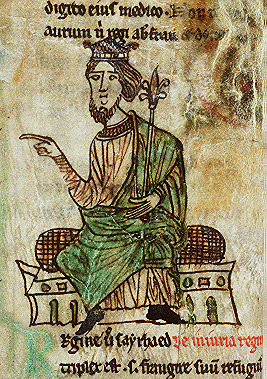 Detail from the book of the Law of Howel Dda
Detail from the book of the Law of Howel Dda
"Dda" means "good".
The King of South Wales, Howel Dda, perceived that the customs of his beloved kingdom were open to abuse. His solution was to call together a meeting of noblemen, archbishops, and bishops to create a framework of binding laws. During Lent, the company spent time together fasting and praying. The King then selected 12 of the wisest men to work with a doctor of law, Blegywryd, to examine the resulting legislation for soundness.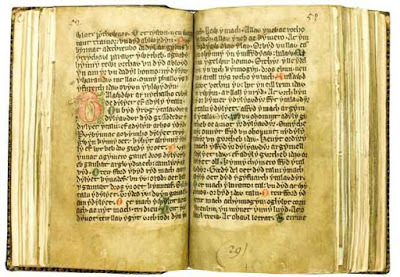 The Laws of Howel Dda
The Laws of Howel Dda
It was decided that because of Wales’ large size (remember this is over a 1,000 years ago when travel was either on foot or horseback, so the distances must have seemed immense) three different groups, or Codes, of laws were needed. These were the Vendotian, Dimetian, and Gwentian Codes. In these Codes there are several interesting laws pertaining to cats.
For a start, a cat was one of the necessary components required to make up a community. It was written that a lawful hamlet consisted of nine buildings, one kiln, one plough, one cock, one bull, one horse, and one cat. (Notice the omission of dogs and horses). In the Dimetian Code it states that if husband and wife separate, then the husband get the cat! That is unless there were several cats in the household, then the man got first pick of the felines and the wife the rest.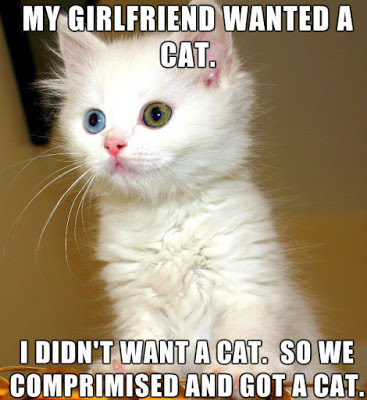
When selling a cat, again according to the Dimetian Code it was the vendor’s responsibility to vouch that the cat won’t go out caterwauling every night (!) but is a good mouser with a full set of teeth and claws, and a good mother to her kittens. The Gwentian Code writes about the qualities of a cat, which was basically to be perfect in tooth, tail, and claw, and (here is the bizarre bit) without ‘marks of fire’. Again, for understandable reasons a cat was also to be a good mouser and mouser – and not caterwaul every moon.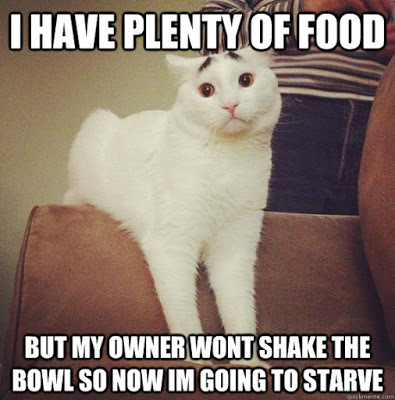
Each cat also had a price. The penalty for killing a cat was four pence. But for a cat that guards a house or barn, the miscreant must pay the equivalent amount of good wheat required to bury a cat that hanging by its tail tip so her nose touched the ground. The Venedotian Code gives a more detailed account of how much a cat was worth.
“A cat from the night it is kittened until it shall open its eyes is a legal penny,From that time until it shall kill mice, two legal pence, And after it shall kill mice, four legal pence.”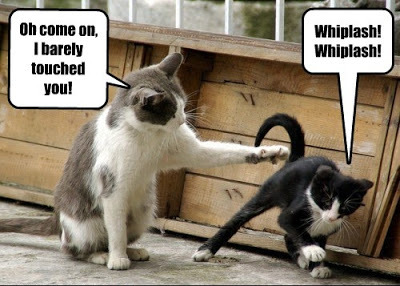
To put this in perspective, one penny was equivalent to a lamb, kid or goose, whilst four pence would buy a sheep or goat. All of which makes me wonder how common cats were in 10th century Wales. After all, you have only to think of how quickly a large feral cat population can become established in our cities, to understand how readily cats breed. For cats to be prized as highly as a sheep – an animal which produces both wool and meat – it makes me suspect our feline friends were much more rare than in the modern age.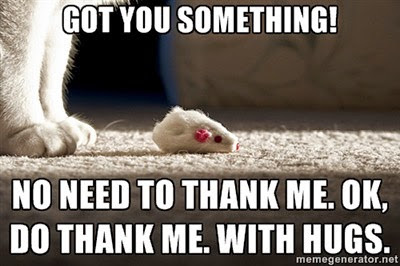
 Detail from the book of the Law of Howel Dda
Detail from the book of the Law of Howel Dda"Dda" means "good".
The King of South Wales, Howel Dda, perceived that the customs of his beloved kingdom were open to abuse. His solution was to call together a meeting of noblemen, archbishops, and bishops to create a framework of binding laws. During Lent, the company spent time together fasting and praying. The King then selected 12 of the wisest men to work with a doctor of law, Blegywryd, to examine the resulting legislation for soundness.
 The Laws of Howel Dda
The Laws of Howel DdaIt was decided that because of Wales’ large size (remember this is over a 1,000 years ago when travel was either on foot or horseback, so the distances must have seemed immense) three different groups, or Codes, of laws were needed. These were the Vendotian, Dimetian, and Gwentian Codes. In these Codes there are several interesting laws pertaining to cats.
For a start, a cat was one of the necessary components required to make up a community. It was written that a lawful hamlet consisted of nine buildings, one kiln, one plough, one cock, one bull, one horse, and one cat. (Notice the omission of dogs and horses). In the Dimetian Code it states that if husband and wife separate, then the husband get the cat! That is unless there were several cats in the household, then the man got first pick of the felines and the wife the rest.

When selling a cat, again according to the Dimetian Code it was the vendor’s responsibility to vouch that the cat won’t go out caterwauling every night (!) but is a good mouser with a full set of teeth and claws, and a good mother to her kittens. The Gwentian Code writes about the qualities of a cat, which was basically to be perfect in tooth, tail, and claw, and (here is the bizarre bit) without ‘marks of fire’. Again, for understandable reasons a cat was also to be a good mouser and mouser – and not caterwaul every moon.

Each cat also had a price. The penalty for killing a cat was four pence. But for a cat that guards a house or barn, the miscreant must pay the equivalent amount of good wheat required to bury a cat that hanging by its tail tip so her nose touched the ground. The Venedotian Code gives a more detailed account of how much a cat was worth.
“A cat from the night it is kittened until it shall open its eyes is a legal penny,From that time until it shall kill mice, two legal pence, And after it shall kill mice, four legal pence.”

To put this in perspective, one penny was equivalent to a lamb, kid or goose, whilst four pence would buy a sheep or goat. All of which makes me wonder how common cats were in 10th century Wales. After all, you have only to think of how quickly a large feral cat population can become established in our cities, to understand how readily cats breed. For cats to be prized as highly as a sheep – an animal which produces both wool and meat – it makes me suspect our feline friends were much more rare than in the modern age.

Published on October 18, 2015 12:18
October 11, 2015
Black Cats: Lucky or Unlucky?
I’m guardian to a black cat: Lucky for me but not so lucky for the mice he eats (they don’t see him coming.)
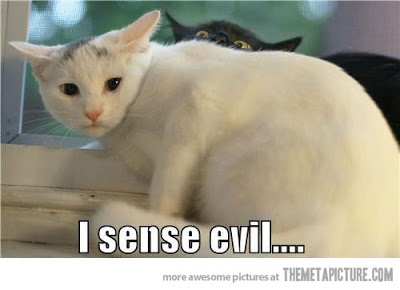
“It is a very unfortunate thing for a man to meet…an ill-favoured woman, a rough-footed hen, a shag-haired dog, or a black cat.” 1620 Anon
In the UK the image of a black cat is commonly used as a notation for good luck, but this hasn’t always been the case. Indeed, whether a cat brings good fortune or bad depends on location, historical period, and the circumstances.
For example, at the beginning of the 20thcentury in Yorkshire fishing village it said a black cat brought good luck when strolling through the village, but was a bad omen on-board ship. Interestingly, having a horseshoe (another symbol of good luck) also became a harbinger of doom when on a ship, so perhaps water brings about a reversal of fortune.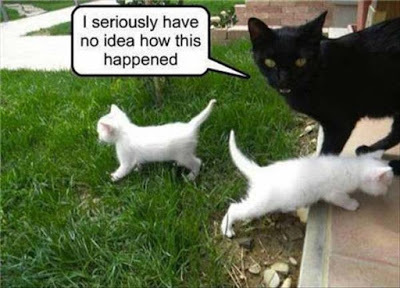
But oh the inconsistencies! In 1890, John Nicholson wrote about local folklore and observed:“It is considered lucky to have [own] a black cat, but unlucky to meet one.”
It seems the situation in which you encounter the cat matters, and there are a number of superstitions that are influenced by the cat’s ‘direction of travel’. For example, a black cat crossing your path is lucky, but to drive a cat away from your door is unlucky. “An Oxford landlady told us …she had driven a black cat away from her door…and since then she had buried 23 relatives.” Wright. 1913
However, a black cat crossing your path is lucky is a little perverse, because the explanation is the cat attracts the bad luck to his unlucky shoulders, thereby freeing you of the burden.
To find out why black cats are so steeped in superstition we need to go back to the days when cats were persecuted by the Christian church. The sleek, mysterious, and enigmatic cat became associated with witches, and black cats especially so. With an undeserved reputation for being witches’ familiars, the black cat’s coat colour doubly linked to the devil. And with severe punishments for being found guilty of witchcraft, you could say it was unlucky to own a black cat.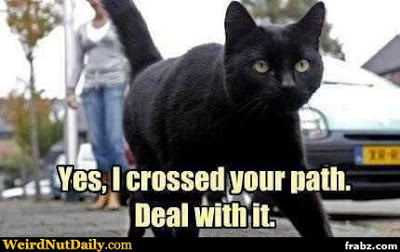
To put a modern twist on things, rescue shelters find it more difficult to home black cats than others. This isn’t for any reasons of superstition, but because they are more difficult to photograph and get a good picture. And with the popularity of social media everyone wants to share photos of their cat…so they pick any colour but black. Shame!

“It is a very unfortunate thing for a man to meet…an ill-favoured woman, a rough-footed hen, a shag-haired dog, or a black cat.” 1620 Anon
In the UK the image of a black cat is commonly used as a notation for good luck, but this hasn’t always been the case. Indeed, whether a cat brings good fortune or bad depends on location, historical period, and the circumstances.

For example, at the beginning of the 20thcentury in Yorkshire fishing village it said a black cat brought good luck when strolling through the village, but was a bad omen on-board ship. Interestingly, having a horseshoe (another symbol of good luck) also became a harbinger of doom when on a ship, so perhaps water brings about a reversal of fortune.

But oh the inconsistencies! In 1890, John Nicholson wrote about local folklore and observed:“It is considered lucky to have [own] a black cat, but unlucky to meet one.”
It seems the situation in which you encounter the cat matters, and there are a number of superstitions that are influenced by the cat’s ‘direction of travel’. For example, a black cat crossing your path is lucky, but to drive a cat away from your door is unlucky. “An Oxford landlady told us …she had driven a black cat away from her door…and since then she had buried 23 relatives.” Wright. 1913

However, a black cat crossing your path is lucky is a little perverse, because the explanation is the cat attracts the bad luck to his unlucky shoulders, thereby freeing you of the burden.
To find out why black cats are so steeped in superstition we need to go back to the days when cats were persecuted by the Christian church. The sleek, mysterious, and enigmatic cat became associated with witches, and black cats especially so. With an undeserved reputation for being witches’ familiars, the black cat’s coat colour doubly linked to the devil. And with severe punishments for being found guilty of witchcraft, you could say it was unlucky to own a black cat.

To put a modern twist on things, rescue shelters find it more difficult to home black cats than others. This isn’t for any reasons of superstition, but because they are more difficult to photograph and get a good picture. And with the popularity of social media everyone wants to share photos of their cat…so they pick any colour but black. Shame!
Published on October 11, 2015 11:41
October 4, 2015
Hey Diddle Diddle: Cats and Nursery Rhymes
I never was a huge fan of nursery rhymes. Although they are meant to entertain small children, I always found them slightly sinister. This is perhaps backed up by the eldest son, who when little used to think the words to “Baa Baa Black Sheep” went:
Baa, baa, black sheepHave you any wool?Yes, sir, yes, sir, Three bags full;One for the monster ….
Obviously this should have been master, but my son misheard.Perhaps I would have liked these rhymes more if they featured cats. So let's see what is on offer.
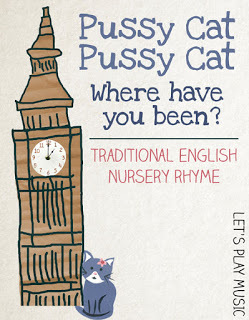
The Cat and the FiddleHey diddle diddle, the cat and the fiddle, The cow jumped over the moon,The little dog laughed to see such funAnd the dish ran away with the spoon
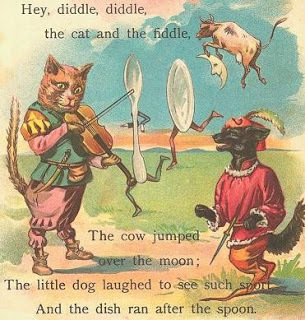
What is the significance of the “cat and the fiddle”?There are several different explanations.
One is that the cat is code for Queen Elizabeth I, and is a comment on her evasive behavior with foreign diplomats. She is famous for skillfully manipulating those emissaries sent by foreign princes to negotiate a marriage contracct with Elizabeth. Some believe this nursery rhyme is a comment on her ability to fiddle and pull the diplomates' strings and play with them as a cat does mice – especially as she never married and was famous for being the virgin Queen. However, nice as this story is, sources believe Hey Diddle Diddle was written around 200 years after her reign – which hardly makes it topical and top of the rhyme-makers mind.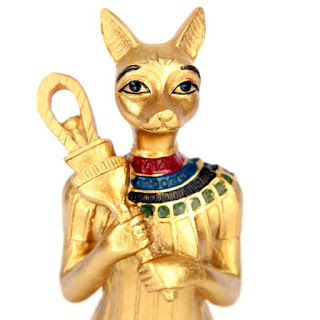 A representation of Bastet
A representation of Bastet
holding a sistrum
Perhaps more convincing is the explanation likening the words to a description of a type of ancient Egyptian instrument called a sistrum. Many ancient depictions of the cat-goddess Bastet show her holding a sistrum which is fiddle-shaped. Intriguingly, the cow and the moon could be represented by another Egyptian goddess, Hathor, who bore horns on her head between which is suspended a large disc.
Alternatively, the “cat and fiddle” could be a corruption of the Latin expression “catus fideles” meaning faithful cat, but to the untrained ear sounding like ‘cat and fiddle’.
The Cat and the Pudding StringSing, sing, what shall I sing?The cat’s run away with the pudding string. Do, do, what shall I do?The cat’s run away with the pudding too.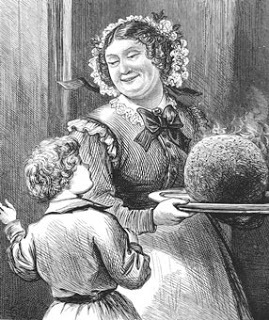
This rhyme is altogether more straightforward. If you’ve ever made traditional Christmas puddings, you’ll have some idea what this is about. The pudding ingredients are mixed and then placed within a large muslin cloth which is gathered around the mix and tied off. The pudding is then steamed or boiled. Obviously, a playful cat took a fancy to the securing string and played with it. Perhaps the cook saw what kitty was about and chastised her, at which point the cat takes off with the string in her mouth and pulls the pudding after her.Simple! (Must have been a small pudding though.)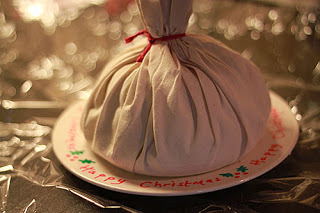
Going to Saint IvesAs I was going to Saint Ives, I met a man with seven wives;Every wife had seven sacks;Every sack had seven cats;Every cat had seven kitsKits, cats, sacks, and wives. How many were there going to Saint Ives? Beautiful St Ives on the Cornish coast of England
Beautiful St Ives on the Cornish coast of England
This one is my favorite because on the face of things it’s a simple test of multiplication. [St Ives is a town in Cornwall.]However, is it instead a trick question? Can you be confident the man with seven wives was indeed going towards St Ives, or could he and his entourage have been walking away (and therefore making the math considerably easier!!) What do you think?
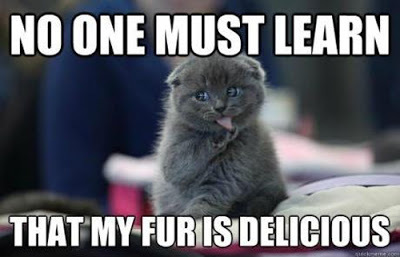
Baa, baa, black sheepHave you any wool?Yes, sir, yes, sir, Three bags full;One for the monster ….
Obviously this should have been master, but my son misheard.Perhaps I would have liked these rhymes more if they featured cats. So let's see what is on offer.

The Cat and the FiddleHey diddle diddle, the cat and the fiddle, The cow jumped over the moon,The little dog laughed to see such funAnd the dish ran away with the spoon

What is the significance of the “cat and the fiddle”?There are several different explanations.
One is that the cat is code for Queen Elizabeth I, and is a comment on her evasive behavior with foreign diplomats. She is famous for skillfully manipulating those emissaries sent by foreign princes to negotiate a marriage contracct with Elizabeth. Some believe this nursery rhyme is a comment on her ability to fiddle and pull the diplomates' strings and play with them as a cat does mice – especially as she never married and was famous for being the virgin Queen. However, nice as this story is, sources believe Hey Diddle Diddle was written around 200 years after her reign – which hardly makes it topical and top of the rhyme-makers mind.
 A representation of Bastet
A representation of Bastetholding a sistrum
Perhaps more convincing is the explanation likening the words to a description of a type of ancient Egyptian instrument called a sistrum. Many ancient depictions of the cat-goddess Bastet show her holding a sistrum which is fiddle-shaped. Intriguingly, the cow and the moon could be represented by another Egyptian goddess, Hathor, who bore horns on her head between which is suspended a large disc.
Alternatively, the “cat and fiddle” could be a corruption of the Latin expression “catus fideles” meaning faithful cat, but to the untrained ear sounding like ‘cat and fiddle’.
The Cat and the Pudding StringSing, sing, what shall I sing?The cat’s run away with the pudding string. Do, do, what shall I do?The cat’s run away with the pudding too.

This rhyme is altogether more straightforward. If you’ve ever made traditional Christmas puddings, you’ll have some idea what this is about. The pudding ingredients are mixed and then placed within a large muslin cloth which is gathered around the mix and tied off. The pudding is then steamed or boiled. Obviously, a playful cat took a fancy to the securing string and played with it. Perhaps the cook saw what kitty was about and chastised her, at which point the cat takes off with the string in her mouth and pulls the pudding after her.Simple! (Must have been a small pudding though.)

Going to Saint IvesAs I was going to Saint Ives, I met a man with seven wives;Every wife had seven sacks;Every sack had seven cats;Every cat had seven kitsKits, cats, sacks, and wives. How many were there going to Saint Ives?
 Beautiful St Ives on the Cornish coast of England
Beautiful St Ives on the Cornish coast of England
This one is my favorite because on the face of things it’s a simple test of multiplication. [St Ives is a town in Cornwall.]However, is it instead a trick question? Can you be confident the man with seven wives was indeed going towards St Ives, or could he and his entourage have been walking away (and therefore making the math considerably easier!!) What do you think?

Published on October 04, 2015 09:32
'Familiar Felines.'
Following on from last weeks Halloween posting, today's blog post looks at the unwanted image of cats as the witches familiar - from the Norse Goddess Freya to lonely women in the middle ages.
The full Following on from last weeks Halloween posting, today's blog post looks at the unwanted image of cats as the witches familiar - from the Norse Goddess Freya to lonely women in the middle ages.
The full post can found at:
http://graceelliot-author.blogspot.com
...more
The full Following on from last weeks Halloween posting, today's blog post looks at the unwanted image of cats as the witches familiar - from the Norse Goddess Freya to lonely women in the middle ages.
The full post can found at:
http://graceelliot-author.blogspot.com
...more
- Grace Elliot's profile
- 156 followers



